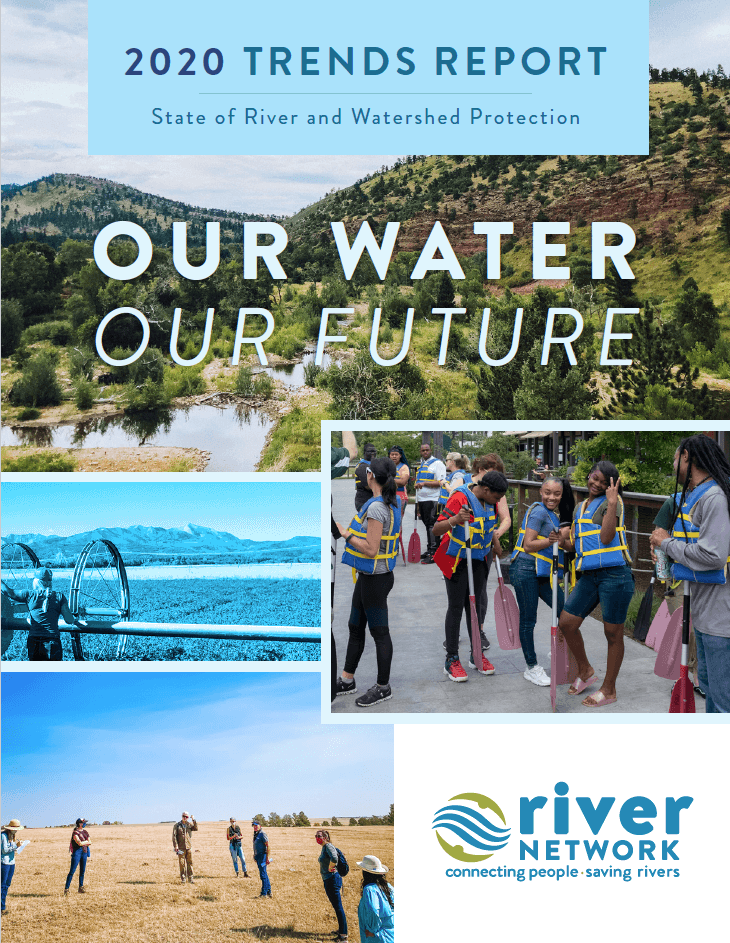Hope, Water, and Community
2020 was quite a year. Floods, fires, water shutoffs, civil unrest, racial injustice, the health crisis of COVID-19, and economic hardship. Our society, our families, and our hearts have all been pushed and pulled, towards worry and grief as well as recovery and resilience, nearly continuously. There is a sense of exhaustion and fatigue in the air from being divided and forced to take sides, too. Yet these divisions, both real and imagined, must be examined if we are to emerge stronger.
Curiously, water and the environment is one area where hope is present—where unity is possible—suggesting another path forward. For example, we know that urban and rural residents both care about the environment and conservation (according to Duke University’s report, Understanding Rural Attitudes Toward the Environment and Conservation in America) and that most Americans (84%) agree that protecting the health of our water is essential to addressing climate change (according to The Urgency of Water published by the Walton Family Foundation). We all benefit when water is clean and our rivers are healthy. These are hopeful trends that have shifted over the past few years.
 We also see conservation and environmental justice organizations coming together as part of national coalitions and collaborations to address water equity and injustice (e.g., Water Equity and Climate Resilience Caucus, Clean Water for All, and the Climate Resilience and Equitable Water Systems Initiative). Together, they’re generating ideas likely to influence future policy agendas as described by the recent Water Affordability and Equity Briefing and Closing the Water Access Gap in the United States reports. We, too, at River Network, have been an active participant in these efforts and others, and expanding the conversation around equity and water, and bringing these ideas to our audience through River Rally, our tools, and other training events.
We also see conservation and environmental justice organizations coming together as part of national coalitions and collaborations to address water equity and injustice (e.g., Water Equity and Climate Resilience Caucus, Clean Water for All, and the Climate Resilience and Equitable Water Systems Initiative). Together, they’re generating ideas likely to influence future policy agendas as described by the recent Water Affordability and Equity Briefing and Closing the Water Access Gap in the United States reports. We, too, at River Network, have been an active participant in these efforts and others, and expanding the conversation around equity and water, and bringing these ideas to our audience through River Rally, our tools, and other training events.
Hope also exists through the perspectives of, and trends over time among our community of water protectors around the country. According to River Network’s newly released 2020 Trends Report Our Water, Our Future: The State of River and Watershed Protection, more local water protectors across our nation believe that conditions are improving for their local waters (50%) as compared to four years ago (36%).
 River Network tracks trends among water protectors working at the local level every three to five years. Data for the 2020 report was collected via survey from nearly 800 people working at the local level across our nation, the majority of which (67%) were staff from nonprofit entities. This year’s report also revealed that over 90% of all respondents nationwide are concerned about water quality and over 85% have concerns about water quantity, similar figures to four years ago.
River Network tracks trends among water protectors working at the local level every three to five years. Data for the 2020 report was collected via survey from nearly 800 people working at the local level across our nation, the majority of which (67%) were staff from nonprofit entities. This year’s report also revealed that over 90% of all respondents nationwide are concerned about water quality and over 85% have concerns about water quantity, similar figures to four years ago.
This improved certainty noted above could be counter-intuitive as it exists side by side with data from other research that suggests public concern about water and the environment is on the rise. On the other hand, the certainty may also suggest a broader recognition about the importance and impact of local efforts and partnerships. Indeed, as the saying goes, all water is local. Since no one entity is responsible for or has authority over all water, a collaborative approach is a necessity, including between and among nonprofits, community members and businesses, farmers, ranchers, utilities, and others.
Yet while our community continues to expand opportunities for women (e.g., women make up 56% of our workforce and hold 33% of senior management and leadership positions), growth of diversity among Black, Indigenous and other People of Color (BIPOC) within our network remains stagnant overall (under 10% of workforce is BIPOC). Our country is stronger because it is diverse, and so too will be our organizations and our solutions. With our population quickly approaching the point where white people will be a minority, to remain socially relevant, our organizations and our movement should reflect the diversity of society as a whole. We made this statement five years ago in our October 2015 issue of River Voices. The good news is there are pockets where change is underway, examples we can point to that show us how to move forward, and momentum we can build upon in our quest to reframe our work to benefit everyone. This is what gives me hope, what I dream about, what I know is within reach.
As I head into the holidays and the close of 2020, this is where I choose to sit: with hope and the prospect of action ahead. Bring it on, 2021.
“Hope” is the thing with feathers
“Hope” is the thing with feathers –
That perches in the soul –
And sings the tune without the words –
And never stops – at all –
And sweetest – in the Gale – is heard –
And sore must be the storm –
That could abash the little Bird
That kept so many warm –
I’ve heard it in the chillest land –
And on the strangest Sea –
Yet – never – in Extremity,
It asked a crumb – of me.
-
[…] Read more from Nicole Silk. […]
Leave a Comment






There are many reasons for hope and positive outcomes for rivers in 2021 and beyond. We need to keep advancing the science and sharing knowledge with the general public. On October 30, 2020, President Trump signed into law America’s Conservation Enhancement Act, which is a huge step in the right direction for conserving wildlife habitat. Now enacted into law, this bill reauthorizes the North American Wetlands Conservation Act (NAWCA) and codifies the National Fish Habitat Partnership (NFHP), two of the most successful voluntary conservation efforts in the nation. The law also reauthorizes the Chesapeake Bay Program and creates funding authorizations for other crucial conservation programs. For more information, go to https://wafwa.org/ace-act/.